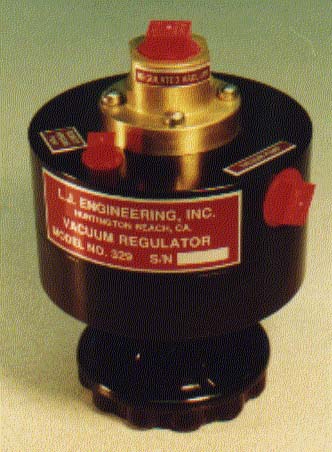|
 L. J. Engineering, Inc.'s Model 329 Vacuum Regulator maintains and controls vacuum within +/-0.01 in-Hg. Its precision-machined aluminum housing, brass, stainless steel, and silicone rubber parts provide a high quality, precision vacuum regulator, which accounts for its use in a wide variety of vacuum control applications. Examples of applications include precision vacuum clamping, low force "pick and place" part handling of delicate materials, low absolute pressure test and calibration systems, vacuum degassing of liquids, cryogenic temperature regulation through low absolute pressure control, altitude simulation chambers, vacuum leak test instrumentation, vacuum bag control, and countless other subatmospheric or less-than-atmospheric pressure (vacuum) control situations. L. J. Engineering, Inc.'s Model 329 Vacuum Regulator maintains and controls vacuum within +/-0.01 in-Hg. Its precision-machined aluminum housing, brass, stainless steel, and silicone rubber parts provide a high quality, precision vacuum regulator, which accounts for its use in a wide variety of vacuum control applications. Examples of applications include precision vacuum clamping, low force "pick and place" part handling of delicate materials, low absolute pressure test and calibration systems, vacuum degassing of liquids, cryogenic temperature regulation through low absolute pressure control, altitude simulation chambers, vacuum leak test instrumentation, vacuum bag control, and countless other subatmospheric or less-than-atmospheric pressure (vacuum) control situations.
All Model 329 Vacuum Regulators control vacuum by throttling the flow to the regulated output as necessary to maintain the set vacuum down stream of the regulator. Flow rates up to 44 SCFM are available. This allows any number of regulators to operate at different vacuum settings while connected to a single vacuum supply manifold. The standard 329 models reference absolute pressure which is useful in calibration and instrumentation, distilling, altitude simulation control, and other vacuum applications where it is desirable to control based on an absolute pressure. Differential pressure reference models are also available that reference atmospheric pressure. These models are useful in applications that must control vacuum relative to atmospheric pressure, such as vacuum clamping, bagging, ink meniscus and liquid level control which are all relative to atmospheric pressure.
Available Models
The vacuum setting of the Model 329 series of vacuum regulators is easily adjusted by turning the control knob, which has a total range of 13 turns, thereby providing very fine adjustment resolution. As shown in the following table, the controllability of the regulator can be optimized for operation at either end of the operational vacuum range (lower differential vacuums or higher vacuums). The optimization also increases the rate of response when adjusting the vacuum level at the optimized end of the operational range.
|
APPLICATION |
MINIMUM
DIFFERENTIAL
VACUUM in. Hg |
MINIMUM
ABSOLUTE
VACUUM in. Hg |
MODEL
NUMBER |
| Standard |
1.30 |
0.25 |
329
329-500
|
| Low Differential Vacuums |
0.40 |
1.50 |
329L
329L-500
|
| Higher Vacuums |
1.80 |
0.20 |
329H
329H-500
|
Self-Relieving Feature Option
In addition to the three models described above (Standard, Low Differential Vacuums and Higher Vacuums), a self-relieving Model 329 Vacuum Regulator is also available. Regulators without the self relieving feature will not reduce the differential vacuum when turning the control knob. In other words, air must be vented into the system or some leakage must be present to reduce the differential vacuum. A regulator with the self-relieving feature will adjust the vacuum in both the increasing and decreasing vacuum directions. The operation and dimensional features are similar to that shown on either the Model 329 or Model 329-500 drawings.
Remote Filter Option
An optional Remote Filter is recommended when the regulator is used in a dusty environment or for continuous operation. The Model 329-500 Vacuum Regulator includes a Remote Filter. This regulator may be used where small particulate matter are present in the surrounding air environment. The Remote Filter attaches to the Model 329 through a short hose and quick-disconnect fitting. The filter is easily removable for cleaning and reuse.
Specifications
Flow Passage at full flow:
0.480 inch diameter
Cv = 3.4 and 12.2 for SHF
Adjustability Range:
From 0.3 inch Hg below atmospheric pressure to near 0 pressure absolute (see Available Models explanation below)
Hysteresis:
Approximately .004 inch Hg (0.1 mm Hg)
Flow Sensitivity:
Flow variation from 0 to 350 liters per minute results in set point shift of less than 0.1 inch Hg.
Weight:
3.6 pounds
Flow Ports:
1/2-inch NPT (female) and 1-inch NPT (female) for SHF
|




